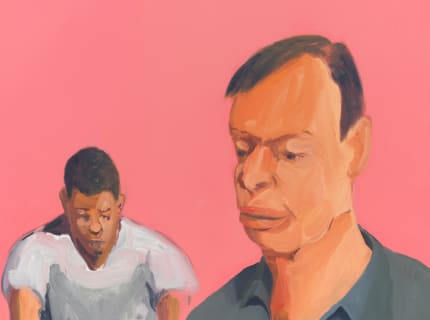The 61-year-old artist, long based in Boston but now living and working in New York, was the subject of “the fire next time,” a survey on view at MASS MoCA in North Adams, Massachusetts, until November 8. The show—whose title alludes to James Baldwin’s 1963 book of essays—included paintings, some of them freestanding portraits with tongues sticking out attached to poles and made to look like signposts. It also featured drawings from “#killers”(2017–ongoing), a series of portraits of racially motivated murderers; a newly commissioned set of sculptures of a faun’s head; and A Partial List of Unarmed African-Americans Who Were Killed By Police or Who Died in Police Custody During My Sabbatical from Massachusetts College of Art and Design, 2014–2015 (2016). That last work is a room-size installation that lists the names of 262 deceased men and women next to a neon sign that reads a dream, invoking a poem by Langston Hughes. Below, Locke discusses his restless and searching approach to portraiture, portraying whiteness and violence without resorting to spectacle, and wanting people to pay attention to crises happening all around them.
How did you start your series of “tongue paintings” (2004–ongoing)?
When I first started painting them, I was thinking about making portraits when there was this thing called “photography.” It seemed strange to be painting straight portraiture in a time of the camera. The camera does portraiture so much better than painting can, and with painted portraiture, you start to get into this whole emotional thing about the painter, which is not what portraiture is [supposed to be] about. Portraiture is about the sitter, not the painter.
Still, I was struggling with giving up straight or neutral portraiture, so I started thinking about the genre’s history, which mostly involves men and images of power: like a picture of the king on money, or a portrait of Jesus high on the wall of a classroom when I was a kid. It wasn’t until years later that I realized the portrait was up there because it had glass in front of it, so the nuns could see what we were doing while their backs were turned. All my life, I thought it was up there because nothing was higher than Jesus. But I realized it was a tool of surveillance.
What drew you to tongues specifically?
If you look to art history, there are people sticking their tongues out everywhere. Once you start seeing them, you see them all over. I started to wonder, What does this gesture mean? It could be a way of being inappropriate or of making a face at someone. Or maybe what you have to say can’t fit inside your mouth. Focusing on tongues started out as a way to push myself past traditional portraiture. But then I really started to think about the implications: it relates to language. It’s sort of sexual, sort of gross, sort of funny. It also goes back to Titian’s The Flaying of Marsyas (ca. 1570s), with Marsyas upside-down with his tongue hanging out. It goes back to my love of art history, and all these sorts of things that happen in paintings, because things happen in paintings that can’t happen anywhere else.
What most drew you to James Baldwin for the title of your show?
We live in such a fraught time, and I don’t think anybody in American letters warned Americans more about America than James Baldwin. He was like, Here’s the problem: we’re sitting around pretending that we’re not related to each other, and it’s too expensive for us to love each other. But if we don’t start to love each other, we’re going to destroy each other. That has become very clear in American life right now, probably more than at any other time I’ve been alive—and I was born during segregation. The warning signs are all there about what is happening in American life: hatred of women, violence against Black people. It’s almost like an orgy of violence against Black people.
The MASS MoCA show is an exploration of different kinds of warnings. We’re in a place where we’re looking at Black people as if they’re not human, as if they’re abstractions. You hear people talk about “the Black body” like it’s an abstract thing, but no—they’re not Black bodies, they’re people. Baldwin presciently said we have to live together—not just exist together but live together, like we’re related, like we’re of the same family.
...
Read full article at artnews.com.

